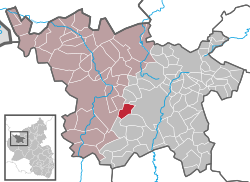Neroth
| Neroth | ||
|---|---|---|
|
||
| Coordinates: 50°11′46″N 6°44′45″E / 50.19603°N 6.74571°ECoordinates: 50°11′46″N 6°44′45″E / 50.19603°N 6.74571°E | ||
| Country | Germany | |
| State | Rhineland-Palatinate | |
| District | Vulkaneifel | |
| Municipal assoc. | Gerolstein | |
| Government | ||
| • Mayor | Egon Schommers | |
| Area | ||
| • Total | 7.24 km2 (2.80 sq mi) | |
| Elevation | 470 m (1,540 ft) | |
| Population (2015-12-31) | ||
| • Total | 846 | |
| • Density | 120/km2 (300/sq mi) | |
| Time zone | CET/CEST (UTC+1/+2) | |
| Postal codes | 54570 | |
| Dialling codes | 06591 | |
| Vehicle registration | DAU | |
| Website | www.mausefallendorf.de | |
Neroth is an Ortsgemeinde – a municipality belonging to a Verbandsgemeinde, a kind of collective municipality – in the Vulkaneifel district in Rhineland-Palatinate, Germany. It belongs to the Verbandsgemeinde of Gerolstein, whose seat is in the like-named town.
The municipality lies in the Vulkaneifel, a part of the Eifel known for its volcanic history, geographical and geological features, and even ongoing activity today, including gases that sometimes well up from the earth.
In 1388, Neroth had its first documentary mention. Neroth arose out of several small centres, namely Niederroth, Hundswinkel and Oberroth. The placename ending —roth refers to clearing woods for farming, and goes back to the 12th century or thereabouts. As an Imperial-knightly village, the Elector of Trier was the fiefholder. With Electoral Trier’s conquest in 1794, the French took over the administration.
As early as 1744, church books mentioned, besides the resident people, wandering families – the Jenische people. They were pedlars and took up residence in winter in Neroth. They distinguished themselves from the long established peasant families with their endogamous marriages and their own language, Jenisch.
Little is known about the French who settled in Neroth. Even today, several French surnames are found in Neroth, such as Leclaire, Jaquemod and Brackonier.
In 1780, Neroth had 215 Morgen (roughly 70 ha) of cropland and about as much again in meadowland, grazing land and woodlands. Raised here were grain, oats and potatoes. The climate and high elevation, however, did not favour farming, and despite hard work, crops often turned out badly. Most of the population lived on potatoes, bread and some vegetables. In the early 19th century, Neroth’s economic situation became critical, though the villagers tried to overcome their neediness by working harder and cutting back on their consumption.
...
Wikipedia



